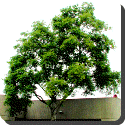 Alder, White — Alnus rhombifolia (White Alder) is an alder native to western North America, from Washington east to western Montana and south to California, occurring at altitudes of 100–2400 m. It has not been reported from northern Baja California but has been predicted to occur there on the basis of its climatic adaptation.
Alder, White — Alnus rhombifolia (White Alder) is an alder native to western North America, from Washington east to western Montana and south to California, occurring at altitudes of 100–2400 m. It has not been reported from northern Baja California but has been predicted to occur there on the basis of its climatic adaptation.
It is a medium-sized deciduous tree growing to 15–25 m (rarely to 35 m) tall, with pale gray bark, smooth on young trees, becoming scaly on old trees. The leaves are alternate, rhombic to narrow elliptic, 4–10 cm long and 2–5 cm broad, with a finely serrated margin and a rounded to acute apex; they are thinly hairy below. The flowers are produced in catkins. The male catkins are pendulous, slender, 3–10 cm long, yellowish, and produced in clusters of two to seven; pollination is in early spring, before the leaves emerge. The female catkins are ovoid, when mature in autumn 10–22 mm long and 7–10 mm broad, on a 1–10 mm stem, superficially resembling a small conifer cone. The small winged seeds disperse through the winter, leaving the old woody, blackish ‘cones’ on the tree for up to a year after.
It is closely related to Red Alder, differing in the leaf margins being flat, not curled under. Like other alders, it is able to fix nitrogen from the air, and thrives on infertile soils.
 Kids Portal For Parents India Kids Network
Kids Portal For Parents India Kids Network






